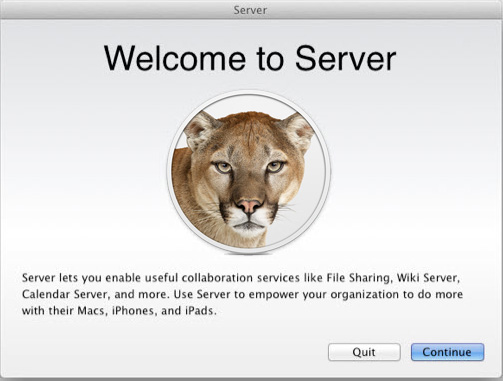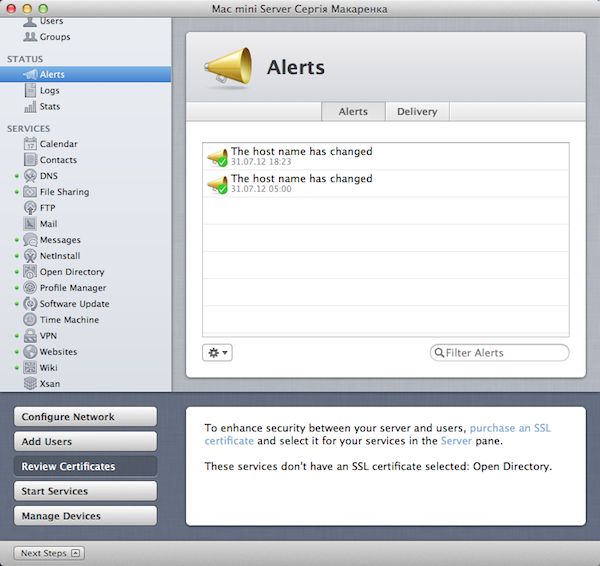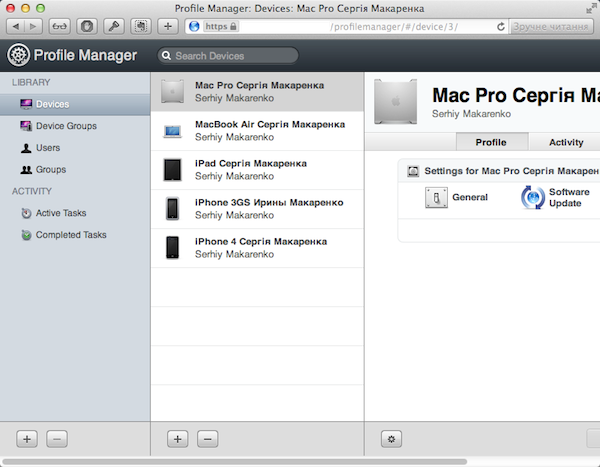- The simplest way to boost your management skills.
- Profile Manager.
- The master multitasker.
- Features for iOS and macOS
- Features for iOS
- Features for macOS
- Advanced by volumes.
- What’s new in macOS Server
- What’s new in macOS Server 5.11.1
- What’s new in macOS Server 5.11
- What’s new in macOS Server 5.10
- What’s new in macOS Server 5.9
- What’s new in macOS Server 5.8
- What’s new in macOS Server 5.7.1
- Записки маковода: немного про OS X Server
- Что теперь из себя представляет сервер.
- Что потерял лично я.
- Что же осталось хорошего?
- В сухом остатке.
The simplest way to boost your management skills.
The advanced features in macOS Server make it easy for you to take control of your organization’s hardware and software. So you can set up and manage every device more effectively.
Profile Manager.
The master multitasker.
Profile Manager simplifies deploying, configuring, and managing the Mac computers and iOS devices in your organization. It’s one place where you control everything: You can create profiles to set up user accounts for mail, calendar, contacts, and messages; configure system settings; enforce restrictions; set PIN and password policies; and more. Profile Manager simplifies the distribution of institution-licensed apps and books purchased through the App Store Volume Purchase Program. It also gives users access to a self-service web portal where they can download and install new configuration profiles, as well as clear passcodes and remotely lock or wipe their Mac, iPhone, or iPad if it’s lost or stolen. And it allows you to perform push installs of macOS enterprise apps and iOS media assets including PDF, EPUB, and iBooks Author files.
Features for iOS and macOS
macOS Server lets you assign Volume Purchase Program (VPP) apps to devices — instead of a user’s Apple ID. This allows for the installation of VPP apps on iOS devices and Mac computers without configuring an Apple ID or sending an invitation. You can also migrate apps already installed on a device to a user’s Apple ID without deleting the app or user data.
Features for iOS
App Store apps — including newly assigned apps and app updates — can be installed even if the App Store is disabled. And apps configured to use Kerberos will automatically launch Per-App VPN when a user logs in to that app. You can enroll iPad and iPhone in the Device Enrollment Program (DEP) and remove the Move from Android option. Network usage rules allow each group or company to specify how managed apps use networks — like restricting the app’s ability to connect over cellular or when roaming on other networks. And you can also update DEP-enrolled supervised devices to the latest iOS version.
macOS Server features restrictions for devices to prevent the use of Mail Drop or AirDrop. You can enable restrictions for supervised devices too, like preventing wallpaper changes, device name changes, modification of enterprise app trust settings, access to iCloud Photos or keyboard shortcuts, Apple Watch pairing, or setting a passcode.
Features for macOS
You can automatically create an administrator account during initial system setup that can be hidden from standard users. Or create a standard account or skip account setup during DEP enrollment, configure the macOS Setup Assistant to create a new standard (non-admin) account, or skip account creation entirely during DEP enrollment.
Advanced by volumes.
Xsan is a powerful and scalable solution for storage consolidation. Everyone in your organization can have fast, concurrent access to terabytes of centralized data. Built into macOS, Xsan allows any Mac to access Xsan or StorNext volumes over Fibre Channel or Ethernet.
Источник
What’s new in macOS Server
Learn about the changes included in macOS Server 5.11.1.
macOS Server 5.11.1 requires macOS Big Sur 11 or later. After installing the macOS update, you can get macOS Server from the App Store. (To prevent interruption of services, new versions of Server aren’t installed automatically, even when App Store preferences are set to install other updates automatically.)
During installation, you might see the message «Server app replacement detected.» This is expected. All Server settings and data are preserved during the update, and you can use the Server app to finish setting up previously configured services after the update.
If you’re upgrading from macOS Server 5.6.3 or earlier, learn about changes introduced in macOS Server 5.7.1.
What’s new in macOS Server 5.11.1
- Profile Manager performance improvements
- New restrictions for Unpaired External Boot to Recovery and Unlock with Apple Watch
- Support for Xsan management is now included in macOS Big Sur. Learn more about migrating to the new tools.
What’s new in macOS Server 5.11
Profile Manager
Profile Manager supports new restrictions, payloads, and commands.
For iOS and iPadOS
- Automated Device Enrollment: Skip Restore Completed and Update Completed panes in Setup Assistant
- Install non-removable managed apps
- Exchange ActiveSync: Override previous password
- Network Usage Rules: Configure SIM rules
- Notifications: Allow Notification previews on lock screen
- Restrictions: Allow App Clips
- WiFi: Disable association MAC randomization
- Include eSIM Identifier «EID» in device info
For iPadOS
- Education: Allow configuring only Shared iPad login window, not Classroom
- Shared iPad: Manage quota-based users
- Shared iPad: Disable temporary sessions
For iOS, iPadOS, and macOS
- VPN: Configure new system extension and network configuration keys
For iOS and tvOS
- Set time zone on supervised devices
For macOS
- Configure Auto Advance
- Automated Device Enrollment: Skip Accessibility pane in Setup Assistant, show Server Activation Lock Bypass Code in device security info
- Install managed apps
- Account Configuration: Managed local user short name
- Associated Domains: Enable direct downloads
- Content Caching: Auto-enable tethered caching, send ContentCachingInformation command
- Restrictions: Allow apps to get file provider info, defer app updates
What’s new in macOS Server 5.10
Profile Manager
Profile Manager supports new restrictions, payloads, and commands.
For iOS and macOS
- Content Caching: Automatically activate Internet Connection Sharing
- VPN: Configure Provider Designated Requirement for Custom SSL connection type
- VPN: Configure network options for Cisco, Juniper, Pulse, F5, SonicWall, Aruba, CheckPoint, and Custom SSL connection types
- Send all traffic through VPN
- Exclude local networks
For iOS
- Disable Shared iPad temporary users
For macOS
- Device Enrollment: Enable FileVault support on first user login
- Query Content Caching information
What’s new in macOS Server 5.9
Profile Manager
Profile Manager supports new restrictions, payloads, and commands.
For iOS, macOS, and tvOS
- Wi-Fi: Configure WPA3 Personal security type
For iOS and macOS
- Add consent text to manually downloadable and enrollment profiles
- Skip Preferred Language and Supported Language panes in Setup Assistant
- Configure extensible single sign-on payload
For iOS
- Skip Dark Mode and Welcome panes in Setup Assistant
- Configure new supervised-only restrictions for allowing external drive access in Files app, continuous path keyboards, and turning Wi-Fi off or on
- Exchange ActiveSync: Enable Mail, Calendar, Contacts, and Reminders individually for managed accounts
- Single App Mode: Configure Voice Control
- Refresh enterprise eSIM cellular plans
For macOS
- Support web-based authentication for Device Enrollment Program
- Skip Screen Time and TouchID panes in Setup Assistant
- Configure new account configuration options for DEP enrollment
- Display Secure Boot and External Boot levels in Device Information
- Support Bootstrap Token to enable mobile accounts to sign in on FileVault Macs
- Manage Activation Lock: Enable Activation Lock, Clear Activation Lock, automatically fetch Activation Lock Bypass Code on Catalina-enrolled Macs
- Configure automatic macOS updates and app updates
- Dock: Configure double click, Recents, and tab settings
- Configure associated web domains payload
- Configure content caching as infrastructure
For tvOS
- Configure whether device will sleep
What’s new in macOS Server 5.8
Profile Manager
Profile Manager supports new restrictions, payloads, and commands.
For macOS
- Export a predefined set of device information values for specified devices using a new command-line tool, exportDeviceInfo
- Skip True Tone pane in Setup Assistant
- Configure new restrictions: screenshot and remote screen observation
- Configure Exchange Web Services authentication certificate
- Configure Apple Remote Desktop access
- Configure managed classes on student Mac computers
- Configure Certificate Transparency payload
For iOS
- Enable or disable Voice and Data Roaming and Personal Hotspot
- Configure new restrictions: Personal Hotspot modification (supervised only)
- Display phone number, ICCID, and IMEI details of enrolled Dual SIM devices
- Configure Certificate Transparency payload
For tvOS
- Configure Managed Software Updates
What’s new in macOS Server 5.7.1
Profile Manager
- Configure an Apple Business Manager account
- Install App Store apps for tvOS
- Configure new restrictions, payloads, and commands:
For macOS
New Restrictions payload settings
- Allow proximity based password sharing requests
- Allow password sharing
- Allow password autofill
- Allow software update installation for non-admin users
New Exchange payload settings
- Use OAuth for authentication
New Smart Card payload settings
- Require Smart Card
- Enable screen saver on Smart Card removal
New Passcode payload settings
- Force password reset during next user authentication
New Security & Privacy payload settings
- Show personal recovery key
New Education payload settings
- Send to teacher-assigned Mac computers
New Xsan payload settings
- Ability to configure automatic mounts
- Ability to specify Distributed LAN Client mount preferences
For iOS
New Restrictions payload settings
- Allow proximity based password sharing requests (supervised devices only)
- Allow password sharing (supervised devices only)
- Allow password autofill(supervised devices only)
- Force automatic date and time (supervised devices only)
- Allow USB restricted mode (supervised devices only)
- Allow managed Contacts accounts to write to unmanaged accounts
- Allow unmanaged Contacts accounts to read managed accounts
- Disable eSIM (supervised devices only)
New Mail and Exchange payload settings
- Allow a user to enable or disable S/MIME signing
- Allow a user to modify the selection of the S/MIME signing certificate
- Allow a user to enable or disable S/MIME encryption
- Allow a user to modify the selection of the S/MIME encryption certificate
New Exchange payload settings
- Use OAuth for authentication
New Notifications payload settings
- Specify whether an app is allowed to send critical alerts
- Allow grouped notifications
- Show in CarPlay
New VPN payload settings for IKEv2 configurations
- Ability to specify DNS server addresses
- Ability to specify primary domain of the tunnel
- Ability to specify DNS search domains
- Ability to specify DNS supplemental match domains
New Setup Assistant pane Device Enrollment skip options
- iMessage & FaceTime and Screen Time
- Add Cellular Plan
For tvOS
New Restrictions payload settings
- Allow proximity based password sharing requests (supervised devices only)
- Install Updates (only appears in the Action pop-up menu when updates are available on the selected Apple TV or Apple TV devices within a group)
Источник
Записки маковода: немного про OS X Server
Спустя некоторое время после того, как я начал пользоваться Mac OS X, у меня возникло желание «пощупать» серверную версию «десятки». Было интересно на нее посмотреть, сравнить с теми же Ubuntu, Debian или Windows Server. Потребовалось полтора года для того, чтобы «созреть» окончательно и в 2010 году я купил Mac mini Server. Тогда эти замечательные компьютеры работали под управлением Snow Leopard Server. Поработав с ним какое-то время, я пришел к выводу, что эта штука очень удобна. Можно настроить много сервисов, которые сделают жизнь с компьютерами в локальной сети намного приятнее. Например, локальный DNS, VPN, FTP, WebDAV, «хостить» там несколько сайтов, среди которых и мой блог. И вообще, вывести уровень комфорта при использовании компьютера на новый. Однако, в процессе настройки и эксплуатации, я понял, что Mac OS X Server требует к себе очень внимательного отношения и ошибок в настройке не прощает. К примеру, DNS очень чувствителен к ним. И если вы допускали ошибку в процессе его настройки, то прямая дорога была в консоль, потому как восстановить нормальную работу сервера можно было только оттуда. Однако, это не помешало мне изучить функциональность системы до того уровня, когда, после настройки необходимых служб, о сервере можно было просто забыть. Вот это «забыть» я не хотел менять даже на новую систему. А потому мимо меня благополучно прошла OS X Lion Server и, возможно, я оставил бы без внимания OS X Mountain Lion Server. Дома я обновил клиентские компьютеры на новейшую OS X Mountain Lion и меня начал волновать вопрос: а сможет ли Snow Leopard Server обслуживать клиентские компьютеры под управлением OS X Mountain Lion? Немного покопавшись в базе знаний Apple, я понял, что нет. И стал готовиться к долгому процессу настройки новой системы.
Что теперь из себя представляет сервер.
Если раньше было две — серверная и клиентская — операционные системы, то сейчас Apple оставила одну, клиентскую, добавив в свою экосистему серверное приложение, которое, будучи установленным на Mountain Lion, активирует в нем серверные функции и позволяет ими управлять. То есть разграничение на сервер и клиент осталось только номинально. Судя по всему, причиной, которая толкнула Apple на такой шаг, стало желание уйти от прежнего цикла разработки параллельно двух ОС, сконцентрировавшись на развитии OS X для домохозяек всех, а серверное приложение дорабатывать и развивать по мере добавления новых функций и сервисов в основную ОС. Вместе с этими правками изменилось и ценообразование. Теперь стать счастливым обладателем серверного программного обеспечения можно всего за 40 у. е. Это положительный момент, поскольку Mac OS X v10.5 Leopard Server стоил заоблачные 1000 у. е., Snow Leopard Server подешевел вдвое, а Lion Server можно было купить «всего» за 80 у. е.
Что потерял лично я.
К моему удивлению в OS X Server в списке служб отсутствуют NAT, DHCP и Firewall. Однако, в системе они формально присутствуют в виде «демонов». Включить NAT, DHCP можно в настройках общего web доступа, но службы будут работать с настройками по умолчанию и настроить их при помощи Server.app нельзя. Поэтому, если вы планировали использовать обновленный сервер как gateway, то командная строка к вашим услугам. Ко всему прочему Apple исключила из комплекта поставки OS X Server программу X11. Поэтому, если вы планируете использовать какое-то UNIX программное обеспечение, требующее X Window System, то вам нужно будет самому обеспокоится его установкой. Поклонникам Wireshark, которые не желают расставаться с OS X, я рекомендую обратить внимание на консольную утилиту tcpdump. Далее. Настройка IM сервера Message Server сведена к минимуму. Его можно только включить и выключить, а также добавить список доменов, с пользователями которых можно общаться. На этом возможности GUI заканчиваются. Однако, если вы хотите осуществить тонкую настройку, то CL утилита serveradmin к вашим услугам и хорошо осведомлена о наборе команд и свойств для «демона» jabberd. Синтаксис ввода команд не изменился и все остальное легко настроить из Terminall.app (за конкретными how-to милости прошу в мой блог). Та же история с Software Update Service. Его можно только включить, выключить из Server.app, а также выбрать автоматическую дистрибуцию обновлений или ручную. Неприятно меня удивила реализация WebDAV. Apple, видимо, сильно мешал модуль Apache mod_dav и они реализовали поддержку протокола так, как посчитали нужным. Теперь получить доступ ко всем публичным WebDAV папкам можно при помощи подключения к такому адресу http://yourserver.com/webdav/. Расшарить при помощи него папку с файлами к корне Apache и зайти на нее по адресу http://yourserver.com/ больше не получится (у меня по такой схеме работал файловый хостинг). В качестве альтернатив присутствуют FTP и AFP (который, традиционно, очень крут). Также, Apple «сломала» работу WebDAV over SSL (еще в OS X Lion) и до сих пор не починила. По этой причине не работает метод PROPFIND. Из-за этого на своем сайте вы не сможете разместить, к примеру, базу OmniFocus или другого продукта, который может синхронизироваться с WebDAV сервером. На этом список недостатков, обнаруженных мной, заканчивается.
Что же осталось хорошего?
Теперь о хорошем. Первое, на что я обратил внимание — это стабильная и ровная работа сервера в целом. Ничего не падает, не ломается. Настройка DNS реализована очень дружелюбно по отношение к неискушенному в этом вопросе пользователю. Теперь, если вы допустите грубую ошибку, у вас не отвалятся все службы, как это было в Snow Leopard Server. То, что Apple отвязала, на сколько это возможно, общую конфигурацию сервера от DNS, мне кажется большим плюсом. На иллюстрации ниже приведен список служб, которые я использую на своем сервере.
Исключая проблему с WebDAV все было настроено или перенесено со старого сервера за пару кликов. При этом, особых проблем с настройкой не возникло. Стоит отметить приятное нововведение в Server.app. Если приложение находит в вашей локальной сети Time Capsule, AirPort Express или AirPort Extreme, которые работают в режиме NAT/router, то оно предлагает взять его под свой контроль. При помощи него Server.app будет автоматически настраивать порты, необходимые для корректной работы служб на сервере, если вы захотите обеспечить к ним доступ из публичного интернета. Отдельно хотелось бы сказать несколько слов о Profile Manager 2.
Profile Manager позволяет удаленно управлять OS X и iOS устройствами. Удаленно можно выполнять большой спектр административных задач. Например устанавливать настройки для VPN, Dock.app, proxy, логина, подключать сетевые принтеры и сногое другое
Это Mobile Device Management решение, которое позволяет управлять удаленно всем парком ваших устройств, начиная с Mac Pro и заканчивая iPod Touch. Настроилась служба за пару кликов и не потребовала каких-либо чрезмерных усилий для того, чтобы разобраться в том, как она работает. Для меня, как администратора локальной сети, это как глоток свежего воздуха.
В сухом остатке.
Это второй, на моей памяти, настолько гладкий старт OS X со времен Mac OS X Leopard. Первым был Snow Leopard. Mountain Lion работает ровно и стабильно, не заставляя напрягаться для решения мелких проблем, которые обычно присутствуют в только что выпущенных продуктах. Mountain Lion вместе с Server.app станут чудесной заменой для устаревших серверных операционным систем и значительно облегчат работу системным администраторам. Так что, если в вашем офисе или компании собралось довольно большое количество клиентского оборудования под управлением OS X или iOS, поторопитесь с покупкой. Автор — маковод со стажем, руководитель сервисного центра computersart.com.ua
Подписывайтесь на наш нескучный канал в Telegram, чтобы ничего не пропустить.
Источник







